
Biosecurity preparedness Oriental Fruit Fly
Oriental fruit fly (OFF), Bactrocera dorsalis, is one of the most destructive horticultural biosecurity threats globally. Over the last 15 years, OFF has dramatically expanded its distribution and now affects large areas of Africa and South East Asia. In Africa, losses due to trade restrictions caused by the spread of OFF are estimated to be US$ 2 billion annually. Established in over 65 countries across Africa and Asia, as well as in our neighbours, Papua New Guinea and Timor-Leste, this fruit fly spreads rapidly, has a host range of over 300 economically important plants and has potential to devastate Australia’s horticultural industries. To date, OFF has not established populations in Australia, but interceptions in northern Australia indicate the severe threat that this species poses as a highly invasive pest. If OFF had established in northern Queensland during the incursions from 1995-1999, the resulting annual management costs were estimated at that time to be $7-8 million (=$13-15 million in 2022 equivalence).
As a major biosecurity risk for Australia, OFF commands a high level of preparedness for response, from both industry and regulatory bodies. This project, a coordinated effort led by Macquarie University partnering with South Australian Research and Development Institute, and New South Wales Department of Primary Industries, assesses biosecurity preparedness of Australia for incursions of OFF and other exotic fruit flies. It documents the best management practices for response to exotic flies through review of national and worldwide management practices, and an assessment of entry, spread and potential establishment of the flies in an Australian context. The project also aims at developing a contingency plan along with science-based movement protocols enabling a quick response to be implemented in the event of an incursion. The outputs will be employed to engage industry as well as key stakeholders in government and support agencies to ensure that knowledge of these pests are well known and that we can test our responses before they are needed.
Funding: Horticulture Innovation Australia Research & Development Grant (FF18001)
Partners: SA Research Development Institute, NSW Department of Primary Industries
Contact: Dr Bishwo Mainali